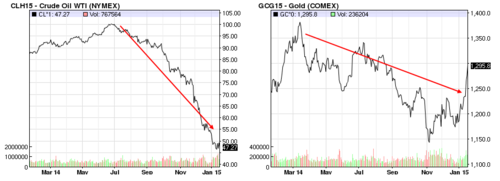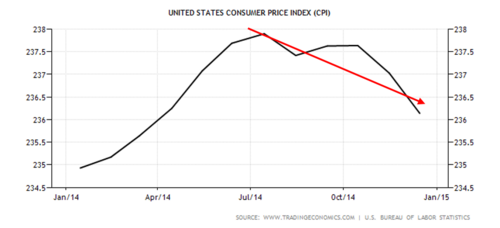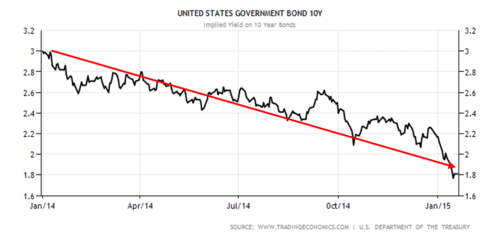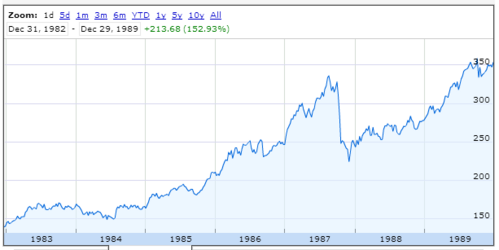Disinflationary Expansion
The world seems a bit confusing to the average investor. Generally, if the US economy is expanding you would anticipate inflation, especially if you consider all the money sitting on the Federal Reserve's balance sheet.
Inflation (dotted line) leads to higher interest rates (solid line) in most cycles.[i]

It's a bit counterintuitive to see the US economy expanding with no signs of inflation - as a matter of fact, perhaps even signs of emerging deflation.[ii,iii]


This trend is coupled with continued drops in interest rates.[iv]

These periods of time, called disinflationary expansions, are when the economy is expanding and yet inflation is slowing. While not pure deflation, it could be a precursor.
We have experienced many periods of time with a disinflationary expansion context. Take for example the period of time from 1983 to 1989.
- We saw the US economy expand by 7.8% a year on average, 141% above the long-term average growth rate of 3.24%.[v,vi]
- We watched average annual inflation slow by 21.6% from 6.16% to 4.83%, reaching a low of 1.91% in 1986.[vii]
- We also witnessed interest rates fall from 10.4% to 7.9%, a 24% decline.[viii]
There were plenty of naysayers about the sustainability of this type of economic juxtaposition. Yet if you sat out this period, you would have missed a market that rallied 153%, one of the strongest markets in the history of US stock markets.[ix]

The world is clearly slowing and central bankers are panicking across the globe. Switzerland, Turkey, Denmark, and India all took extraordinary measures in the last week, following China’s rate cut last November.

Meanwhile, the US continues to move deeper into its disinflationary expansion phase.
So what asset classes and sub-asset classes can benefit from the underlying characteristics of this period?
- Lower rates would benefit longer duration bonds, as well as high yield investments.
- Real estate has some very long duration and generally fixed payments.
- Clearly from our 1980's example, the S&P 500 would also be an excellent asset class to exploit.
While this period of time is fraught with the risk of turning purely deflationary, it can also be an excellent time to take advantage of this environment.
That’s exactly what we will try to do in the coming months.
If you have questions or comments, please let us know as we always appreciate your feedback. You can get in touch with us via Twitter, Facebook, or you can email me directly. For additional information on this, please visit our website.
Tim Phillips, CEO – Phillips & Company
Jeff Paul, Senior Investment Analyst – Phillips & Company
References
[i] TradingEconomics.com. (Jan 20, 2015). US Govt 10-Yr Bond and Inflation Rate.
[ii] Nasdaq.com. (Jan 20, 2015). Oil and Gold Price Charts
[iii] TradingEconomics.com. (Jan 20, 2015). US Consumer Price Index.
[iv] TradingEconomics.com. (Jan 20, 2015). US Government Bond 10 Year.
[v] Federal Reserve Economic Data. (Jan 20, 2015).
[vi] TradingEconomics.com (Jan 20, 2015). US GDP Annual Growth Rate.
[vii] InflationData.com (Jan 20, 2015).
[viii] Federal Reserve Economic Data. (Jan 20, 2015).
[ix] Google Finance. (Jan 20, 2015).
[x] Baghdjian, A. and Koltrowitz, S. (Jan 15, 2015). Swiss central bank stuns market with policy U-turn. Reuters.
[xi] Candemir, Y. (Jan 20, 2015). Turkey Central Bank Cuts Rates Amid Political Pressure. The Wall Street Journal.
[xii] Durden, T. (Jan 19, 2015). Denmark Goes NIRP-er; Slashes Rates To -20bps Amid Currency Peg Fears. ZeroHedge.com.
[xiii] Bradsher, K. (Jan 14, 2015). Suddenly, India Cuts Interest Rates. The New York Times.
[xiv] Wei, L. (Nov 23, 2014). China Central Bank Cuts Interest Rates. The Wall Street Journal.